Get the weekly SPARTANAT newsletter.
Your bonus: the free E-Book from SPARTANAT.
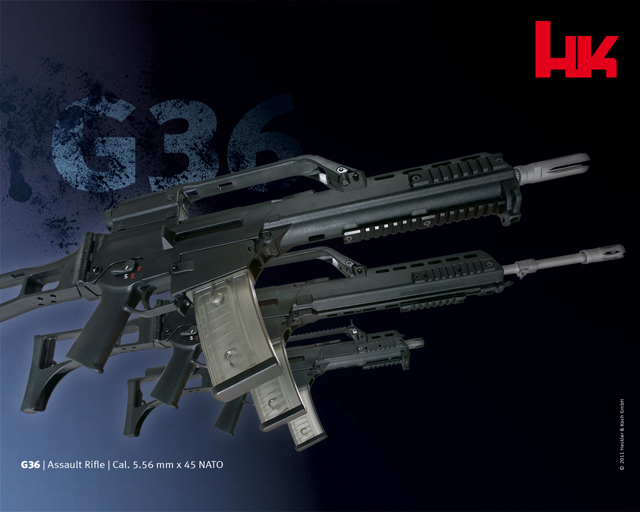
G36 - Heckler & Koch answers again
It's as if one world talks past another: The Bundeswehr communicates through the directive of the Inspector General, who refers to expert opinions that are not made public. But parts are leaked. Corresponding leaked excerpts are usually found in major mass media. If you want to have the original statements of selected expert opinions: HERE on the blog AUGEN GERADEAUS you will find some key excerpts from expert opinion parts. Quite strange: H&K wants to have the reports in order to be able to competently comment on them, but they are not given access to them. At the same time, the statements of the Bundeswehr are slightly contradictory. Heckler & Koch respond in turn to the fragments from the media. We document the response here in full:
Statement No. 6 from Heckler & Koch on the Assault Rifle G36
Bundeswehr testers ignored the introduced HK rifle MG36
Proofing cycles and evaluation methods apparently arbitrarily changed
Comparability of the latest results with previous investigations, as well as with the requirements of the technical supply conditions and regulations of the Bundeswehr impossible
BMVg refuses to release the report
A few days after the latest investigation report on the G36 became known, there are indications that cast serious doubts on the technical credibility of the conduct of the tests and the conclusions drawn from them.
Bundeswehr testers ignored the introduced HK rifle MG36
Together with the currently known standard rifle G36, another variant of the G36, the MG36, was successfully tested and introduced in the mid-1990s under the designations 1005-12-336-6892 and 1005-12-336-6893. Thus, the MG36 can be requested by the troops at any time via the supply route or procured by the BAAINBw without further testing.
The MG36, as a variant of the G36, was supposed to take on the function of a light machine gun in the infantry weapons mix.
In July 1995, the federal government ordered 4,700 MG36 rifles from Heckler & Koch, but due to a change contract requested by the Bundeswehr in October 1997, they were ultimately not procured. Unaffected by an actual procurement, the MG36 is in any case an officially introduced weapon by the Bundeswehr based on the assault rifle G36 in NATO caliber 5.56mmx45.
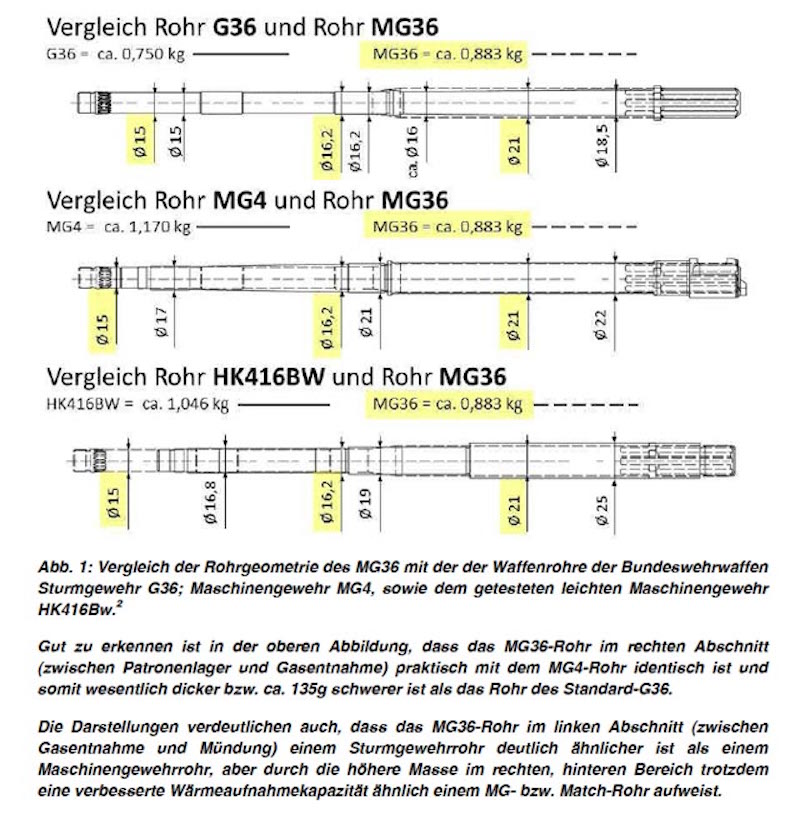 The MG36 is identical to the G36, but has a significantly thicker barrel than the G36; however, the MG36 only weighs about 135g more than the G36.1
The MG36 is identical to the G36, but has a significantly thicker barrel than the G36; however, the MG36 only weighs about 135g more than the G36.1
Therefore, an MG36 barrel is technically much more similar to a G36 assault rifle barrel than the barrel of the recently tested special weapon HK416Bw, which has almost 50% more barrel mass, while the MG36 barrel has only about 20% more barrel mass compared to the G36 barrel.
The question arises why the already introduced MG36 was not tested in the recent comparative tests, while obviously a technically incomparable HK416Bw, as well as models from other manufacturers, were acquired and considered.5
Once again, in this context, the two WTD91 small arms experts mentioned in H&K press release No. 5 seem to have played a central role, who had also established and spread the so-called "plastic theory" regarding the material of the G36 housing:
Delivery documents show that in the mid-1990s WTD91 not only received several HK50 or G36 test weapons in the MG36 variant, but even a complete set of drawings of this G36 variant with a thick barrel.6 From H&K documents, it can be seen that WTD91 received at least eight MG36 weapons in total.
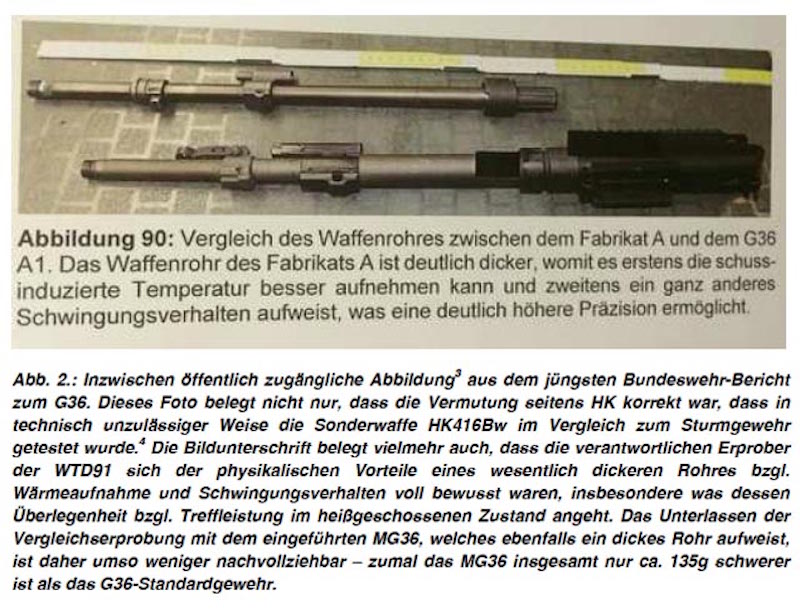 Therefore, the central question is whether these two experienced employees ignored the MG36 and in particular the fact that this G36 variant has a thick barrel which, due to the physics of hot firing, has better performance parameters regarding precision, in the recent test planning. However, even more pressing is the question why these two experts did not include the MG36 in the latest comparative tests, even though it would have been scientifically necessary to verify the "plastic theory" put forward by these two individuals as the sole cause of the problem by examining the thicker barrel of the MG36 and the influence of the barrel geometry on an otherwise identical weapon housing.
Therefore, the central question is whether these two experienced employees ignored the MG36 and in particular the fact that this G36 variant has a thick barrel which, due to the physics of hot firing, has better performance parameters regarding precision, in the recent test planning. However, even more pressing is the question why these two experts did not include the MG36 in the latest comparative tests, even though it would have been scientifically necessary to verify the "plastic theory" put forward by these two individuals as the sole cause of the problem by examining the thicker barrel of the MG36 and the influence of the barrel geometry on an otherwise identical weapon housing.
In particular, the question arises why these two small arms experts between late 2011 and mid-2014 failed to mention the MG36, discuss it in the known technical discussions at H&K, or even test it, while based on statements made public during the Federal Press Conference, it is evident that weapons from other manufacturers were specifically acquired and tested against the standard G36 with the technically and tactically incomparable light machine gun HK416Bw.
Proofing cycles and evaluation methods apparently arbitrarily changed
From the current numerous media reports, which mention allegedly poor shooting performance of the G36 in the hot-fired state, it must be concluded that in the latest investigations, the test firing cycle for checking the shooting performance in the hot-fired state was apparently changed once again.7
Only three years ago - in March 2012 - the so-called "Operational firing cycle" (EBZ) was defined by the Bundeswehr after long discussions, within which it is undisputed that the G36 still achieves acceptable shooting performance (as of the end of 2013).
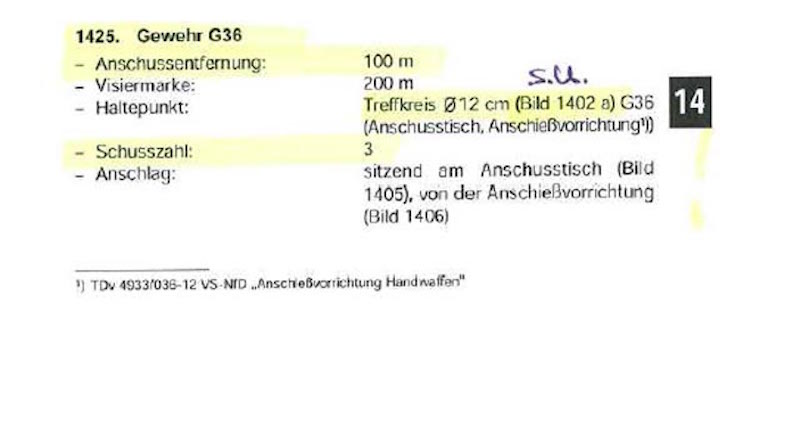 Why then at the end of 2014 a different test firing cycle was apparently defined again is not clear. Since the media-reported shooting results with the G36 supposedly were very poor in this new scenario, the new test fire cycle must have been significantly tightened, especially or shortened.
Why then at the end of 2014 a different test firing cycle was apparently defined again is not clear. Since the media-reported shooting results with the G36 supposedly were very poor in this new scenario, the new test fire cycle must have been significantly tightened, especially or shortened.
This raises the question of why this new test firing cycle was defined by the Bundeswehr. From media reports, it can be deduced that these new test parameters are supposed to be based on allegedly new demands from the troops based on the "current operational reality," particularly referring to Afghanistan and the so-called Good Friday battle.
In fact, our experience in cooperation with the Bundeswehr during almost 15 years of Afghanistan deployment shows that the Bundeswehr does not have an operation-related reporting system that even comes close to being suitable to represent technical parameters in such detail that a specific test firing cycle8 for a laboratory test could be derived from it. Besides the quality of the reporting system, this is simply impossible due to the level of detail regarding these parameters, as logically almost every battle unfolds differently in terms of these detail parameters.
It can therefore be assumed that there was a deliberate or arbitrary shortening or tightening of the test firing cycle with the aim of presenting the G36 as insufficiently powerful. When this did not succeed immediately, the special weapon/light machine gun HK416Bw with an extremely thick barrel, atypical for an assault rifle, was included in the test program in order to then argue that for the allegedly new demands of the troops, a technically feasible solution is available on the market.
If we try a car comparison, this would be roughly equivalent to "proving" that a horsepower-strong standard car is "far too slow" because it "loses" a race against a Formula 1 car.
Comparability of the latest results with previous investigations, as well as with the requirements of the technical supply conditions and regulations of the Bundeswehr impossible
The current media coverage gives the impression that a G36 does not achieve operationally acceptable performance under the allegedly "new conditions."
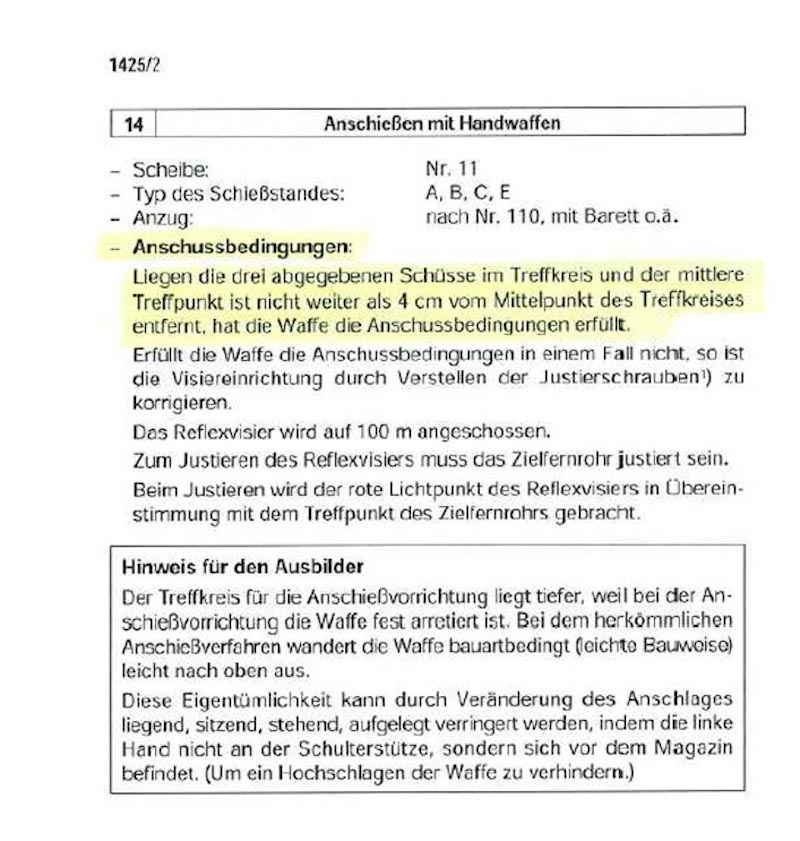 Actually, this statement is impermissible and currently technically unverifiable, as one of the main points of contention in the previous investigations by the WTD91 was always their lack of comparability with the technical supply conditions or the firing conditions of the troops.
Actually, this statement is impermissible and currently technically unverifiable, as one of the main points of contention in the previous investigations by the WTD91 was always their lack of comparability with the technical supply conditions or the firing conditions of the troops.
While according to the valid Bundeswehr service regulation9 with a rifle G36 in use, three shots must be within a 12cm circle at 100m and up to three repeat attempts are allowed, the WTD91 has so far arbitrarily set, without any Bundeswehr regulations to support it, the more stringent standard that 10 shots (i.e., more than three times as many shots as required by the specification) are to be evaluated using a mathematical so-called D90 method, which provides a purely theoretical hit value that cannot be compared with actually shot groupings.
Since 2011, the WTD91 has also never used, in the H&K known G36 tests, the prescribed aiming device for rifles in use G36, as mandated by Bundeswehr regulations, but rather an shooting device not covered by Bundeswehr regulations. Furthermore, as the national testing authority of the Bundeswehr, WTD91 has always refused to use the H&K aiming device, which was used under the supervision of the Bundeswehr quality control office for the acceptance of the approximately 178,000 G36 rifles.
Therefore, all shooting results of WTD91 are not comparable with the precision requirements of the technical supply conditions for new G36 rifles, nor with the valid Bundeswehr regulations of the ZDv 3/12 for rifles in use G36.
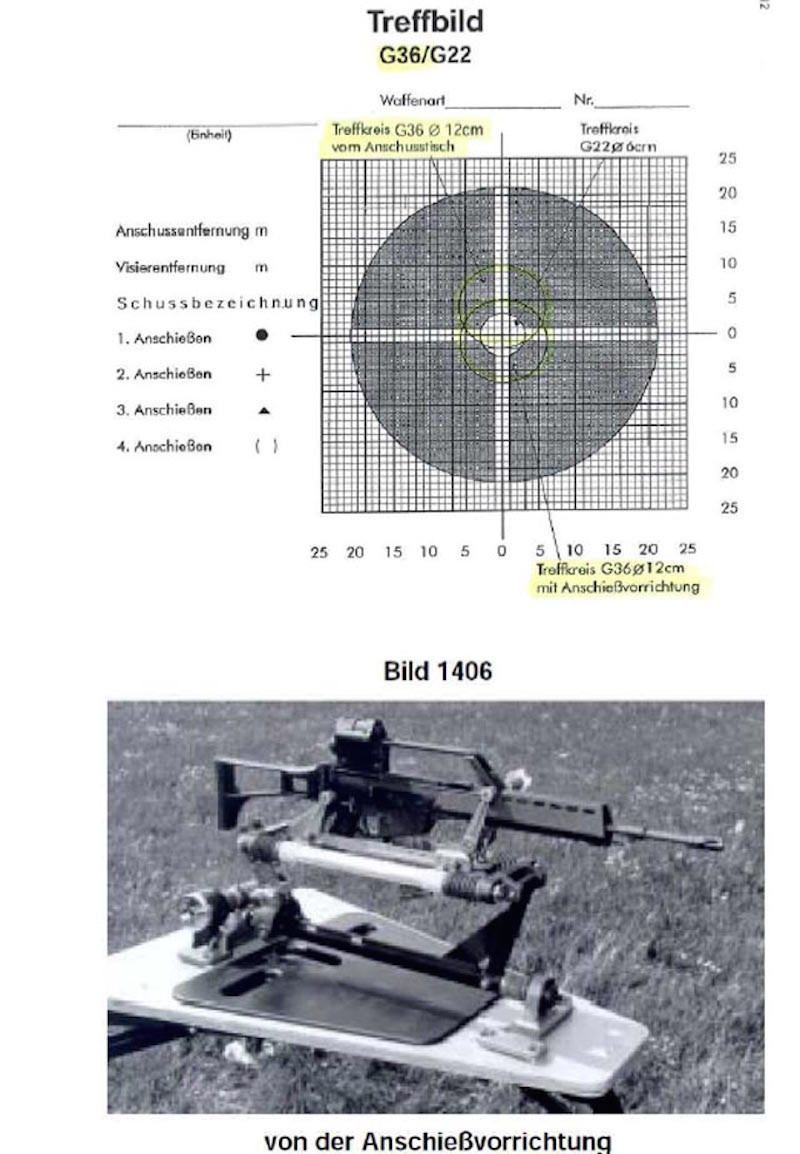 Below are the relevant excerpts from the ZDv 3/12:
Below are the relevant excerpts from the ZDv 3/12:
BMVg refuses to release the report - Detailed analysis by HK impossible
Heckler & Koch has been repeatedly called upon from the media and political space to comment on the test procedures and results of the recent tests and to enter into a dialogue with the Bundeswehr on this.
HK welcomes and supports this approach. Unfortunately, despite repeated personal and public requests, the Bundeswehr has not engaged in technical dialogue with Heckler & Koch regarding the current allegations and has refused to provide the report to Heckler & Koch despite repeated requests.
Press Office Heckler & Koch GmbH
1Specification without magazine and bipod
2See comments on the presumed test of the HK416Bw in HK press release No. 4 on the G36; as well as the publicly available illustration below from the latest Bundeswehr report.
3http://augengeradeaus.net/2015/04/gesucht-wird-g36-vergleichswaffe-a-von-hecklerkoch/
4See remarks in the HK press release No. 4 on the G36
5See statements by the government representative Flosdorff at the Federal Press Conference on 01.04.2015.
6See HK delivery notes regarding MG36 weapon and MG36 drawing deliveries from 03.01.1994, 26.06.1995, and 02.11.1998
7See, among others, "Süddeutsche Zeitung" from 19.04.2015, article "Quick replacement demanded,"
SPARTANAT is the online magazine for Military News, Tactical Life, Gear & Reviews.
Send us your news: [email protected]
Ad
similar
Get the weekly SPARTANAT newsletter.
Your bonus: the free E-Book from SPARTANAT.


